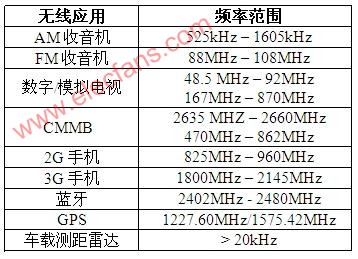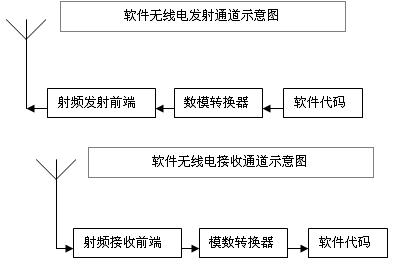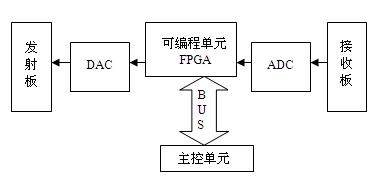
These have not included infrared wireless applications, remote control keys, etc., plus the wireless Internet and 4G communication networks that will definitely be integrated into the car in the future, car-related wireless systems will cover a considerable range. However, wireless applications must not only be applicable to the relevant frequencies, but also meet the prescribed modulation algorithm. Therefore, the existing in-vehicle wireless applications are implemented using separate hardware and software modules. For example, radio, a common solution is to use a radio module for radio demodulation, and then interact with the main processor through a special communication protocol (such as I2C) and display it on the man-machine interface.
Independent hardware and software modules usually mean simple software design and lower hardware cost. But it also has its weaknesses: changes in hardware modules usually mean relatively large system changes. For example, if the radio needs to add RDS functions, it is generally necessary to reselect a new radio module, redesign the system interface to adapt to the new radio module, and redesign the software to accommodate the RDS function.
In-vehicle wireless applications involve numerous independent hardware modules and rapidly evolving new technologies. Simultaneously changing hardware modules and modifying software modules may result in lagging time to market and higher design costs. Software radio is a booming field. The following article will discuss the introduction of software radio modules in vehicle systems.
Introduction to Software Radio
Traditional radio applications rely on analog circuits. The purpose of software radio is to turn hardware problems in the radio field into software problems. The basic idea is to demodulate the received electromagnetic waves with software and control the emitted electromagnetic waves with software. The basic framework of software radio is shown below.

As you can see from the block diagram, the analog-to-digital / digital-to-analog converter is a bridge that connects continuous analog signals and discrete digital signals, and what the software can control is digital signals. Application software codes efficiently analyze and reasonably control digital signals. In principle, software radios can realize all applications of traditional radios, and have the flexibility that traditional radio equipment does not have-software codes can be adjusted in real time according to user needs. That is to say, using the same piece of hardware, software radio software can complete the tasks that traditional radio requires multiple pieces of hardware to complete, such as receiving FM signals and TV signals at the same time.
Car software radio
Now is the time to consider using software radios to replace traditional radio applications in cars. To implement this solution, you first need to design a general software radio module. This module should include the module in the schematic diagram, and it should have better flexibility. Finally, it must have a high-speed interface to communicate with external devices. The figure below gives a simple schematic example.

Among them, DAC is a digital-to-analog converter, ADC is an analog-to-digital converter, and BUS is a programmable interface.
Second, take a look at the FPGA as a programmable unit. After the main control unit configures the FPGA through the programmable interface, the FPGA will work according to our pre-designed program. In the field of software radio, taking receiving as an example, the tasks completed by the FPGA include converting ADC data into baseband data according to the frequency band specified by the main control unit, so-called digital down conversion. This conversion used to consume system resources in the past. With the improvement of hardware processing capabilities and the update of software algorithms, the uplink and downlink conversion in the radio field can basically be completed in real time. Both Xilinx and Altera provide high-performance FPGAs, which are fully capable of performing the above tasks.
Secondly, the data after the digital down conversion will be transmitted to the main control unit through the programmable interface. The flow of this data will vary greatly depending on the application and the digital down conversion algorithm. The typical data rate is tens of megabytes per second. This speed can be adapted to the current wireless systems commonly used in cars, and the general interface that meets this data rate can be selected:

In general, the USB bus is a good choice: simple and easy to get.
The data is transferred to the main control unit via the interface / bus, and the main control unit will process the data according to user requirements. Today's embedded processors not only have a main frequency of more than 1GHz, but also multi-core, such as Intel Atom, which has a floating point calculation capability of one billion times per second is enough for applications to complete the work required by software radio.
The role of radio frequency (transmit / receive) boards and digital-to-analog / analog-to-digital converters is very important, and their performance will directly determine what kind of problems the software radio can handle. Theoretically, the sampling frequency of the converter must be at least twice the frequency to be measured. However, a converter with a very high sampling rate is more expensive. The radio frequency board can be used to reduce the frequency to be measured from a higher frequency band to the working frequency band of the converter. The RF boards on the market can reduce the frequency of RF signals up to 6GHz to below the intermediate frequency of 10MHz, and the 20MHz converter is easier to find and has good accuracy (16 bits).
So far, the general software radio module has been successfully built. The rest is to use the imagination of product designers and software engineers to design and develop perfect car radio applications. A handy example is the use of software radio, as long as a headset is assigned to each seat, each passenger can independently choose the favorite FM station without being affected by others-this is in a system with only one FM radio module Is an impossible task.
It is certain that with the existing technology, it is completely feasible to realize diversified in-vehicle radio applications. However, radio is a controlled field in various countries, and applications without authorization are generally not available on the market. As the technology matures, I believe that the control methods in this field will also be improved, so that the majority of automotive users can enjoy the free experience brought by the wireless application of in-vehicle software as soon as possible.
Summary of this article
There is no doubt that using software radio to replace traditional in-vehicle wireless applications can not only bring great flexibility to the design of in-vehicle wireless systems, but also produce many innovative applications. Although there is still a long way to go from design to implementation, we must believe that everything can be a powerful interpretation of the future by technology.
We have experience and skill to support customers to tooling for their required waterproof connectors, like IP68 series,micro fit connectors. Etop wire assemblies for various industries have been highly recognized by all the customers and widely used for automobiles, electrical and mechanical, medical industry and electrical equipemnts, etc. Products like, wire harness for car audio, power seat, rear-view mirror, POS ATM, Diesel valve Cover gasket fit, elevator, game machine, medical equipment, computer, etc.
JST Connector,Molex Connector, Multi-Contact Connector, Micro Fit Connectors
ETOP WIREHARNESS LIMITED , https://www.wireharness-assembling.com